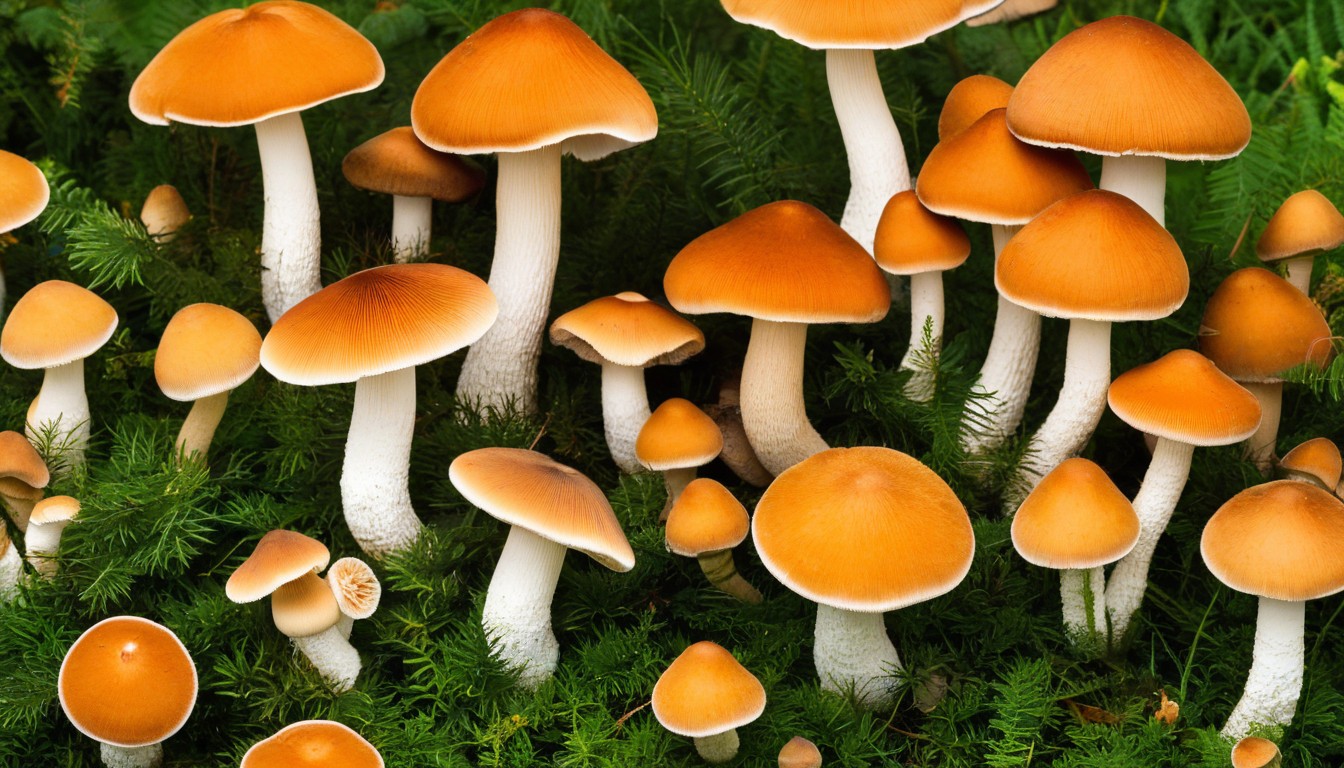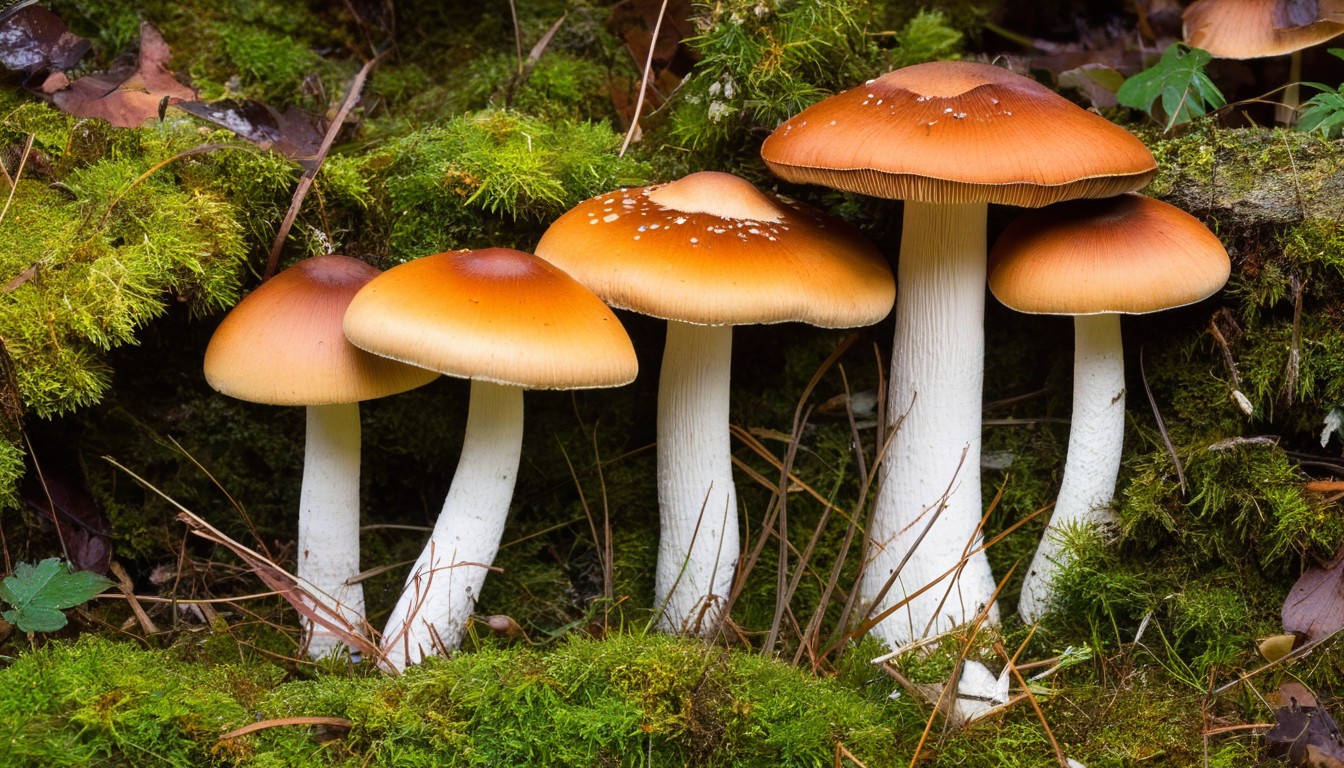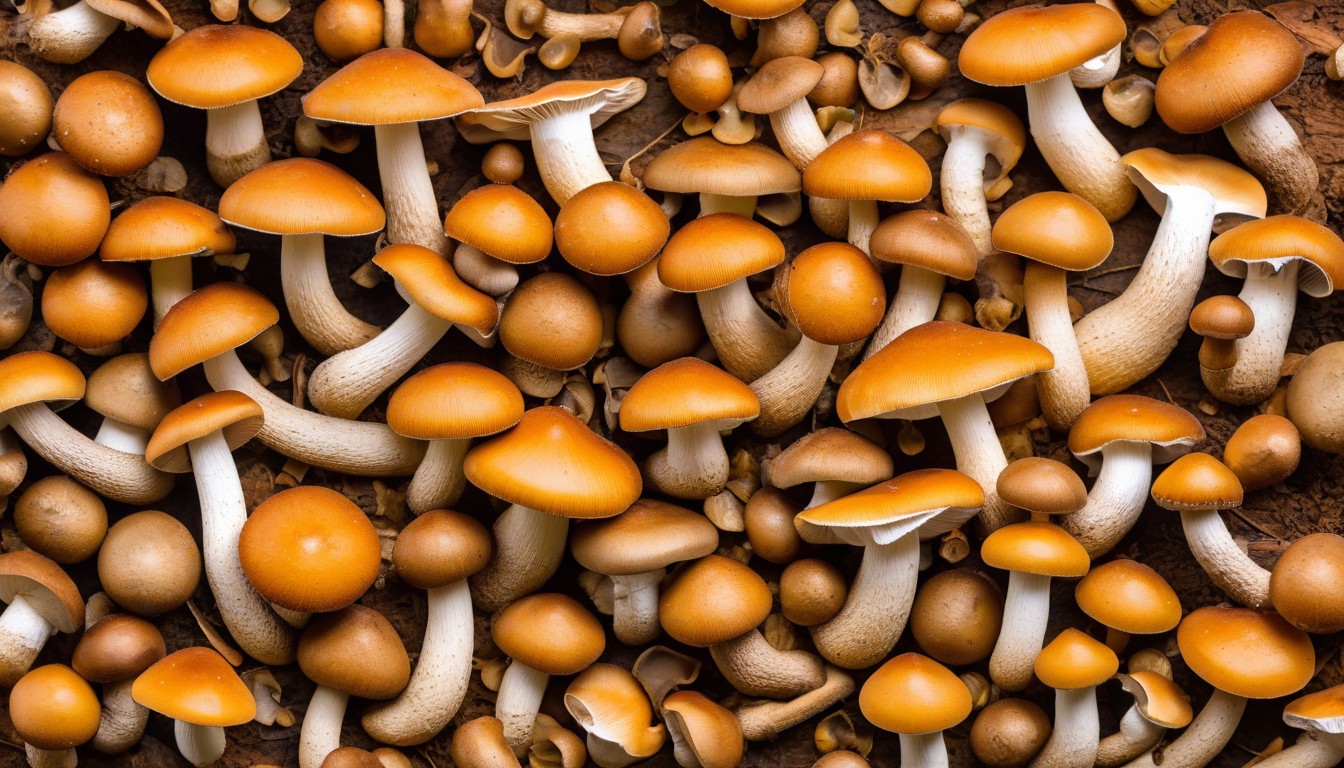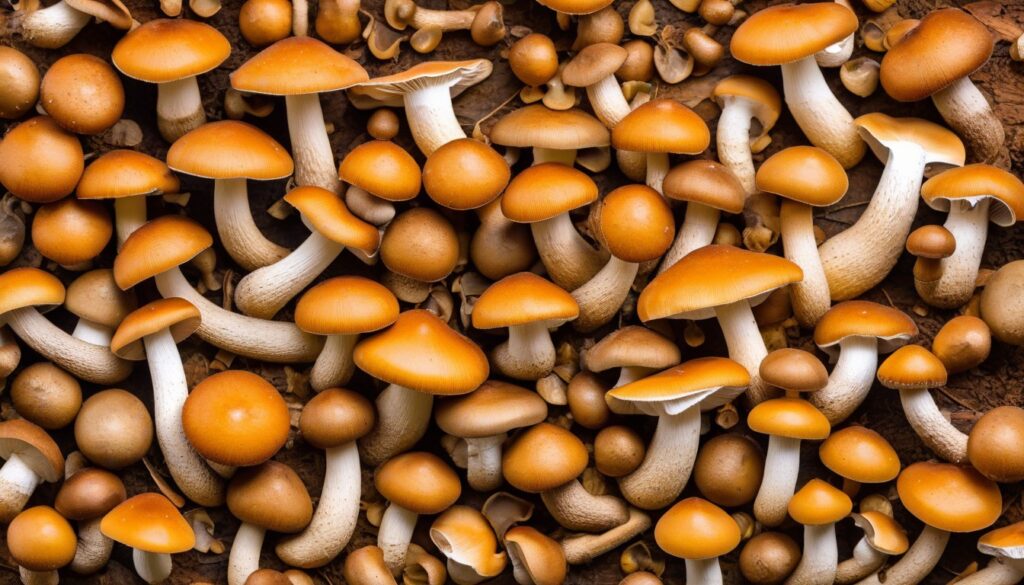Michigan is home to a plethora of edible fall mushrooms just waiting to be discovered. Whether you’re an avid forager or new to the hobby, this guide will help you navigate the world of mushroom foraging in Michigan. From identifying edible mushrooms to cooking them to perfection, we’ve got you covered.
Key Takeaways
- Michigan is a haven for edible fall mushrooms.
- This guide provides valuable information for both beginner and experienced foragers.
- Proper identification of mushrooms is essential for safe foraging.
- Michigan offers guided foraging tours and exciting mushroom-themed festivals.
- Edible fall mushrooms offer many health benefits and are a tasty addition to any meal.
Types of Edible Fall Mushrooms in Michigan
Michigan is home to a diverse range of edible fall mushrooms, each with its unique flavor, texture, and appearance. In this section, we will take a closer look at some of the most popular types of edible fall mushrooms that you can find in Michigan forests.
|
Mushroom Name |
Description |
Flavor Profile |
|---|---|---|
|
Chanterelles |
Golden-yellow with an apricot-like scent and wavy, vase-shaped caps. |
Nutty and fruity. |
|
Grayish-blue or brown with an oyster shell-like appearance. |
Crisp and mild. | |
|
Honey Mushrooms |
Yellow-brown with honeycomb-like cap texture. |
Sweet and nutty. |
|
Hen of the Woods |
Grayish-brown with ruffled cap and a feather-like appearance. |
Earthy and meaty. |
|
Thick and meaty with a round, brown cap and white pores underneath. |
Intense and nutty. | |
|
Black Trumpet Mushrooms |
Black, funnel-shaped and smoky with a smooth texture. |
Earthy and fruity. |
These are just a few of the many types of edible fall mushrooms that can be found in Michigan. Remember to always properly identify the mushrooms before consuming them and never eat mushrooms that you are unsure about. With the right knowledge and tools, mushroom foraging can be a delightful and tasty experience.
Best Spots for Mushroom Foraging in Michigan
Michigan is home to many great spots for mushroom foraging. Here are some of the best locations to find a bountiful harvest of edible fall mushrooms:
|
Location |
Best Time to Forage |
Types of Edible Mushrooms Found |
|---|---|---|
|
Huron-Manistee National Forests |
September to October |
Hen of the Woods, Chanterelles, Porcini |
|
Leelanau Peninsula |
September to November |
Black Trumpets, Chanterelles, Hen of the Woods |
|
Sleeping Bear Dunes National Lakeshore |
September to October |
Hen of the Woods, Chanterelles, Morels |
When choosing a foraging spot, consider factors such as the terrain, weather conditions, and accessibility. Look for areas with a high diversity of tree species, such as oak and maple, which provide ideal habitats for many edible mushroom varieties.
Remember to always obtain permission from the landowner before foraging, and follow ethical foraging practices by leaving some mushrooms behind for others and not damaging the surrounding environment.
Mushroom Identification Tips and Techniques

Identifying edible fall mushrooms in Michigan requires a keen eye and a solid knowledge of their physical characteristics and habitats. To help you confidently distinguish between edible and non-edible varieties, we’ve put together a list of useful tips and techniques.
1. Study Physical Characteristics
Take note of the color, texture, shape, and size of the mushroom. Pay attention to its cap, stem, and gills. These physical characteristics can help you determine its species and edibility.
2. Understand its Habitat
Each mushroom species has its unique habitat, from the type of tree it grows near to the soil type it prefers. Knowing where to look for specific species can increase your chances of finding edible mushrooms.
3. Use a Field Guide
Carry a comprehensive field guide that has detailed descriptions and pictures of various mushroom species. It can be helpful in identifying a mushroom and ensuring its edibility.
4. Do a Spore Print Test
Spore print test involves leaving a mushroom cap on a piece of paper and allowing it to release its spores overnight. The spore print’s color can be useful in identifying the mushroom species.
5. Seek Expert Advice
When in doubt, seek advice from experienced foragers, store owners, or experts. They can help you identify the mushroom species and share their tips on foraging for mushrooms safely and responsibly.
Safety Precautions for Mushroom Foraging
Foraging for mushrooms in Michigan can be a fun and fulfilling experience, but it’s crucial to prioritize safety. To ensure a safe foraging adventure, follow these essential safety precautions:
- Know the poisonous mushrooms: Before setting out to forage, familiarize yourself with the poisonous mushroom varieties in Michigan. Avoid any mushrooms that you are not 100% sure are edible.
- Use a field guide: A field guide can be a valuable tool for identifying edible mushrooms and avoiding poisonous varieties. Bring one along on your foraging trip.
- Wear protective clothing: While foraging, wear long sleeves and pants, gloves, and sturdy shoes to avoid exposure to poisonous plants or insects.
- Avoid contaminated areas: Avoid foraging near industrial areas, roadsides, or other areas that may be contaminated by chemicals or pollutants.
- Don’t trespass: Always ask for permission before foraging on private property, and avoid foraging in unauthorized areas, such as state parks or nature reserves.
By following these safety precautions, you can ensure a safe and successful mushroom foraging experience in Michigan.
Necessary Foraging Tools And Equipment

Foraging for edible fall mushrooms in Michigan can be an exciting adventure. To make the most of your foraging trips, it’s essential to carry the right tools and equipment. Here are some of the essential items you should consider when preparing for your foraging experience:
Basket
A basket is the best way to collect your mushrooms. Choose a sturdy, open-weave basket that allows spores to fall through, promoting the growth of new mushrooms.
Knife
A reliable knife is necessary for harvesting mushrooms. Choose a sharp, sturdy knife with a serrated or curved blade to cut through tough stems.
Field Guide
Carrying a field guide helps you identify and differentiate edible and poisonous mushrooms. Invest in a comprehensive guide that features high-quality photos and detailed descriptions of the mushrooms you may encounter.
Protective Gear
Protective gear is an important consideration when foraging for mushrooms. Wear gloves to protect your hands from thorns and prickly plants, and a long-sleeved shirt and pants to protect your skin from insects, poison ivy, and other irritants. Consider wearing a hat to shield your face from the sun and bug spray to keep pesky insects away.
Reusable Containers
Bring reusable containers to carry your harvested mushrooms. Choose containers that allow air to circulate and avoid using plastic bags that can cause your mushrooms to sweat and spoil quickly.
By carrying these essential items, you’ll be prepared for a successful mushroom foraging experience in Michigan.
Cooking and Preserving Edible Mushrooms

Congratulations, you’ve found a variety of delicious fall mushrooms! Now it’s time to cook them up and enjoy their unique flavors.
Cooking Techniques
There are various ways to prepare edible mushrooms, depending on their texture and taste. Sauteing is a popular method that brings out their natural umami flavor while preserving their texture. To saute edible mushrooms, heat a non-stick pan over medium-high heat with a bit of oil. Then, add sliced mushrooms to the pan and stir occasionally until they are golden brown and have released their moisture. Serve them as a side dish, on toast, or as a topping for your favorite pasta.
Another fun way to cook mushrooms is by roasting them in the oven with garlic and herbs. Clean and slice the mushrooms, then drizzle them with olive oil, salt, pepper, and your desired herbs. Roast them in a preheated oven at 375°F for 20-25 minutes, or until they are tender and golden brown. Serve with your favorite protein or alongside roasted vegetables for a hearty meal.
Recipes
Need some recipe inspiration? Check out this delicious recipe for Mushroom Risotto:
|
Ingredients: |
Instructions: |
|---|---|
|
– 1 lb. of mixed edible fall mushrooms |
1. Clean and slice the mushrooms. Set aside. |
|
– 1 onion, diced |
2. In a separate pot, sauté the onion with olive oil over medium heat until it’s translucent. |
|
– 3 cloves garlic, minced |
3. Add the garlic to the pot and cook for 1 minute. |
|
– 1 cup arborio rice |
4. Add the arborio rice to the pot and toast it for 2-3 minutes, stirring constantly. |
|
– 4 cups vegetable broth |
5. Pour in the vegetable broth a bit at a time, stirring continuously until the rice has absorbed the liquid and is tender. |
|
– 1/2 cup white wine |
6. Add the white wine and cook for an additional 2-3 minutes. |
|
– 1/4 cup grated Parmesan cheese |
7. Stir in the grated Parmesan cheese and the sliced mushrooms. |
|
– Salt and pepper to taste |
8. Add salt and pepper to taste and serve hot. Enjoy! |
Preserving Methods
If you’ve gathered more mushrooms than you can eat, don’t worry! Mushrooms can be preserved in various ways to enjoy later on. One of the most popular methods is to dry edible mushrooms. Simply clean and slice them, then lay them out on a baking sheet in a single layer. Bake at the lowest temperature possible until they are completely dry, then store them in a cool and dry place.
Another method is to pickle mushrooms – they make a delicious addition to salads or cheese boards. Clean and trim the mushrooms, then place them in a jar with vinegar, water, salt, and your desired herbs and spices. Store the jar in the fridge for at least 24 hours before serving.
With these cooking and preserving tips, you can enjoy your foraged mushrooms all year long!
Unique Culinary Uses for Michigan Mushrooms

Fall mushrooms are not only delicious but also incredibly versatile in the kitchen. Michigan is home to a variety of edible mushrooms that can transform a dish, add unique flavor, and offer various health benefits. Here are some creative culinary uses for these foraged treasures.
Mushroom Broth
In Michigan, mushroom broth is a popular staple and a great way to use up extra mushrooms. It’s simple to make by simmering a variety of mushrooms with aromatics and herbs, and it’s loaded with rich umami flavor. The broth can be used as a base for soups, stews, or risottos, or even drunk on its own as a satisfying, low-calorie snack.
Mushroom Toast
This dish is a twist on the classic avocado toast. Spread a creamy goat cheese or ricotta over a toasted slice of bread, and top with sautéed Michigan mushrooms, garlic, and thyme. Finish it off with a drizzle of olive oil and a sprinkle of sea salt. This tasty twist on toast is an excellent breakfast or lunch option that can also be served as an appetizer.
Mushroom Tea
Michigan’s fall mushrooms make a surprisingly delicious tea with a subtle earthy flavor. Simply boil dried mushrooms, strain, and add honey or lemon, depending on your preference. Serve it hot or cold for a warm, comforting drink with a twist.
Mushroom Gravy
Tired of traditional gravy? Try making a mushroom-based version instead. Sauté Michigan mushrooms with butter, thyme, and garlic, then add flour and whisk in broth. Let it simmer and thicken before adding a splash of cream and a pinch of salt. This decadent gravy is perfect for roasted vegetables, mashed potatoes, or your favorite cut of meat.
Mushroom Chips
Yes, you read that right. Michigan mushrooms can be turned into delicious and healthy chips. Simply slice them thinly, toss them in olive oil and salt, and bake them in the oven until crispy. These savory chips make a perfect snack on their own or can be added as a crunchy topping to salads and soups.
Michigan’s fall mushrooms offer a myriad of culinary possibilities that can take your cooking skills to the next level. Whether you’re a seasoned chef or an adventurous home cook, incorporating these unique ingredients into your meals will delight your taste buds and impress your guests.
Health Benefits of Edible Fall Mushrooms
Adding edible fall mushrooms to your diet provides numerous health benefits. Let’s take a look at some of them:
|
Health Benefit |
Description |
|---|---|
|
Boosts Immunity |
Edible fall mushrooms contain beta-glucans, which can enhance your immune system by stimulating the production of white blood cells. |
|
Reduces Cholesterol |
The high fiber content in edible fall mushrooms can help reduce cholesterol levels and prevent heart disease. |
|
Improves Digestion |
The polysaccharides present in edible fall mushrooms can help improve digestion and prevent bloating and constipation. |
|
Rich in Vitamins and Minerals |
Edible fall mushrooms are a rich source of vitamins B, C, and D, as well as minerals such as potassium, copper, and selenium. |
|
May Have Anti-Cancer Properties |
Some studies suggest that certain compounds found in edible fall mushrooms, such as polysaccharides and ergothioneine, may have anti-cancer properties. |
Incorporating these tasty mushrooms into your meals can be an easy way to add nutritious value and promote overall health.
Guided Mushroom Foraging Tours in Michigan
If you’re a novice forager or want to learn from experienced hunters, Michigan offers numerous guided mushroom foraging tours hosted by experts. Embark on a unique adventure and explore the diverse landscapes of Michigan on a guided tour while learning about the different types of edible fall mushrooms. These tours are ideal for those who want to get an in-depth knowledge of foraging in Michigan.
Here are some popular guided mushroom foraging tours in Michigan:
|
Foraging Tour |
Location |
Duration |
|---|---|---|
|
Wild Food Foraging Walk |
Burt Lake State Park |
2 hours |
|
Mushroom Foraging Adventure |
Ann Arbor |
4 hours |
|
Edible Mushroom Hunting |
Southwestern Michigan |
3-4 hours |
These guided tours are perfect for beginners, providing a safe and educational experience for both individuals and groups. Keep in mind that each tour is unique, with varying terrains, duration, and difficulty levels. Consider your interests and experience when choosing a tour that suits you best.
Most of these tours typically take place during the fall season when the mushroom picking conditions are ideal. Make sure to book in advance and check with the tour operators to confirm the schedule and availability of the tours.
Fall Mushroom Foraging Events and Festivals in Michigan
If you’re looking to immerse yourself further in the world of mushroom foraging, Michigan offers a range of events and festivals celebrating the region’s bountiful harvests. From educational walks to mushroom-themed feasts, these gatherings are perfect for connecting with fellow enthusiasts and discovering new ways to enjoy Michigan’s mushrooms.
1. National Morel Mushroom Festival
Every May, the town of Boyne City hosts the National Morel Mushroom Festival, a four-day event that draws in crowds from all over the country. The festival features guided foraging excursions, cooking demonstrations, food vendors, and live entertainment. It’s a must-visit for any serious mushroom enthusiast.
2. Mid-Michigan Mushroom Show
This annual show, held in Lansing usually in late September, is a great opportunity to learn more about the fascinating world of mushrooms. The event includes displays of various mushroom species, lectures, and guided walks around the surrounding woods and parks. You’ll leave with a greater appreciation for the local biodiversity and some newfound knowledge about mushroom identification.
3. Mushroom Feast Redux
The Mushroom Feast Redux is an annual event held in late October or early November at the Zingerman’s Roadhouse in Ann Arbor. This feast showcases Michigan-grown mushrooms, with dishes ranging from mushroom risotto to mushroom-themed desserts. You’ll get to savor the natural flavors and textures of Michigan’s fall mushrooms while rubbing shoulders with other mushroom enthusiasts.
These are just a few of the mushroom foraging events and festivals that Michigan has to offer during the fall season. Whether you’re a seasoned forager or a curious beginner, attending these events can be a great way to deepen your knowledge and appreciation of mushrooms.
Conclusion
Michigan is a treasure trove of edible fall mushrooms waiting to be foraged. By following the guidelines provided in this comprehensive guide, you can confidently and safely hunt for mushrooms while enjoying the delicious flavors they offer. Remember to always prioritize safety by choosing the right foraging spot, identifying mushrooms correctly, and carrying the necessary equipment.
From classic mushrooms to unique ones, Michigan has a lot to offer. You can cook and preserve these wonderful mushrooms to enjoy their flavors all year round. Not only do they taste delicious, but they also offer numerous health benefits, making them a great addition to your diet.
If you’re looking for a guided experience, Michigan offers various mushroom foraging tours and festivals that you can attend. It’s a great way to learn from experts while enjoying the beautiful landscapes and connecting with like-minded enthusiasts.
The world of mushroom foraging in Michigan is waiting for you. Get ready to embark on your next adventure and explore the wonders of fall mushrooms in Michigan!
FAQ
Can anyone forage for edible fall mushrooms in Michigan?
Yes, anyone can forage for edible fall mushrooms in Michigan. However, it is important to have proper knowledge and identification skills to ensure that you are picking safe and edible varieties. It is recommended to learn from experienced foragers or attend guided tours to enhance your mushroom foraging skills.
What are some common types of edible fall mushrooms in Michigan?
Some common types of edible fall mushrooms in Michigan include the Chanterelle, Morel, Hen of the Woods, Chicken of the Woods, and Black Trumpet. These mushrooms are known for their distinct flavors and are highly sought after by foragers.
Where are the best spots for mushroom foraging in Michigan?
Michigan offers a variety of mushroom foraging spots. Some popular locations include state parks, national forests, and nature reserves. It is important to research and obtain necessary permits or permissions before foraging in these areas. Local mycological societies and nature conservancies can provide valuable information on the best spots in Michigan.
How do I identify edible fall mushrooms in Michigan?
Proper identification is crucial when foraging for mushrooms. It is recommended to study field guides and take part in workshops or classes to learn about the physical characteristics and key identification features of edible fall mushrooms in Michigan. It is also important to cross-reference your findings with expert mycologists or experienced foragers to ensure accuracy.
What safety precautions should I take when foraging for mushrooms in Michigan?
Safety should always be a priority when foraging for mushrooms. Some important precautions to follow include: only picking mushrooms that you are confident in identifying as edible, avoiding areas with industrial pollution or heavy pesticide use, wearing appropriate protective gear, and always consulting a mycologist or expert if you have any doubts about a mushroom’s edibility.
What tools and equipment do I need for mushroom foraging in Michigan?
For mushroom foraging in Michigan, it is recommended to carry a basket or foraging bag to collect the mushrooms, a sharp knife for clean cutting, a field guide or smartphone app for identification, a small brush for cleaning the mushrooms, and protective gear such as gloves and a mushroom brush to avoid any potential harm.
How can I cook and preserve the edible fall mushrooms I find in Michigan?
There are various cooking techniques and preservation methods for edible fall mushrooms. Cooking techniques include sautéing, grilling, roasting, and incorporating them into soups and stews. Preservation methods include drying, freezing, and pickling. It is important to properly cook or preserve the mushrooms to maintain their flavor and ensure food safety.
Are there any unique culinary uses for Michigan mushrooms?
Yes, there are plenty of unique culinary uses for Michigan mushrooms. You can create mushroom-infused oils, use them in risottos or pastas, make mushroom-based sauces or gravies, or even experiment with incorporating them into desserts, such as mushroom-infused ice cream or chocolate truffles. The possibilities are endless!
What are the health benefits of consuming edible fall mushrooms?
Edible fall mushrooms offer a range of health benefits. They are low in calories and fat, yet high in vitamins, minerals, and antioxidants. Some specific health benefits include immune system support, improved digestion, reduced inflammation, and potential anti-cancer properties. However, always consult with a healthcare professional before making any drastic changes to your diet.
Are there any guided mushroom foraging tours available in Michigan?
Yes, Michigan offers guided mushroom foraging tours led by experienced foragers and mycologists. These tours provide valuable knowledge and an opportunity to learn about different mushroom species and their habitats. It is a great way to enhance your foraging skills and connect with like-minded enthusiasts.
Are there any fall mushroom foraging events or festivals in Michigan?
Michigan hosts various fall mushroom foraging events and festivals that celebrate the abundance of edible mushrooms. These events provide an opportunity to connect with the mushroom foraging community, participate in guided forays, attend educational workshops, and enjoy delicious mushroom-centric meals. Some popular events include the Michigan Mushroom Hunters Club Forays and the National Morel Mushroom Festival in Boyne City.

